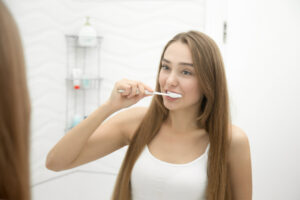Plaque buildup and tartar on teeth invite bacteria, leading to oral health issues, including cavities and gingivitis. Therefore, plaque removal should be critical to your oral hygiene routine. While visiting a dentist for dental cleaning is essential if you have dental issues, plaque removal can also be managed at home.
This article will guide you on effectively removing plaque and preventing tartar buildup.
What is Plaque?
Plaque refers to a sticky film found on your teeth. It is caused when bacteria in your mouth infest on sugary or starchy food and drinks. This can be considered as an initial stage of teeth discoloration. If not treated, it develops into tartar, which causes several dental complications.
What are the Symptoms of Plaque?
The common symptoms of plaque that you should watch out for are:
- Persistent and chronic bad breath
- Fuzzy feeling on teeth
- Tender, red, and swollen gums that may even bleed when brushing
Tartar vs Plaque
When you fail to remove plaque from your teeth, it hardens and creates a deposit on your teeth.
While plaque is only restricted to teeth, tartar goes deep into your gums, leading to gum diseases.

What are the Symptoms of Tartar?
The common symptoms of tartar that you should be aware of are:
- Rough feeling on teeth
- Yellow discoloration of teeth
- Swollen gums
- Bleeding from gums
How to Remove Plaque from Teeth?
The best way to preserve oral hygiene and prevent plaque from developing into tartar is to remove plaque. Plaque removal is no rocket science; it is easy to do with good oral hygiene.
There is no substitute for a good oral routine. It will not only help you with plaque removal but also maintain your pearly whites. Here’s what you need to do:
-
Brushing
Brushing your teeth twice daily is the first step to plaque removal. To brush your teeth properly, you need to:
- Maintain your toothbrush at a 45-degree angle against your gum line.
- Do not put too much pressure, and brush gently.
- Brush pits and crevices of the top of the teeth where you chew.
- Make sure to brush for at least 2-5 minutes.
-
Flossing
Brushing is essential because it removes plaque from your teeth. However, it does not help with plaque removal between the teeth or under the gum line. This is where flossing steps in. Dentists usually recommend flossing with unwaxed floss at least once daily for thorough cleaning.
To floss correctly, you need to:
- Gently move the floss between your teeth and use a back-and-forth motion to clean.
- Curve the floss thread to create a “C” shape and move up and down along the sides of each tooth.
- Repeat this method for every tooth.
- You can also use a water flosser instead of a floss thread. It sprays water between your teeth and helps remove plaque.
-
Mouthwash
Certain mouthwashes can also help you decrease plaque on your teeth when combined with brushing and flossing. Antimicrobial mouthwashes effectively reduce bacteria in your mouth, which contributes to plaque. In addition, you can also use fluoride mouthwashes to strengthen your teeth and prevent them from being damaged.
-
Oil Pulling
An ancient Ayurvedic technique involves swishing edible oil around your mouth, preferably coconut or sesame. Several studies have shown that it reduces plaque formation and helps keep teeth healthy.
-
Baking Soda
Brushing teeth with baking soda is also helpful in removing plaque. Use a thick paste of baking soda and water. Although this may help you remove plaque, this technique may not have enamel-strengthening properties. Alternatively, you can get a toothpaste containing baking soda and plaque for the solution.

How to Remove Tartar from Teeth?
Tartar is difficult to remove and cannot be treated at home. Although regular brushing and flossing may help, you may need to visit a dentist for complete tartar removal. In addition, your dentist may also recommend other treatment options for ultimately protecting your teeth and gums.
To Sum It Up
Plaque forms from bacteria, sugar, starch, and acid in the mouth. It starts as a sticky film on teeth and eventually hardens into tartar. While it is possible to do plaque removal at home, tartar requires professional dental care.
Don’t let plaque and tartar compromise your oral health.
Routine dental visits and professional cleanings are essential for maintaining a healthy, beautiful smile. At Valley Ridge Dental, our experienced team is ready to help you achieve oral hygiene and manage dental concerns.
Contact us at (651) 439-0322 or schedule your consultation.





